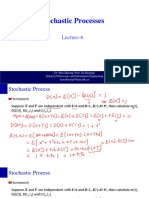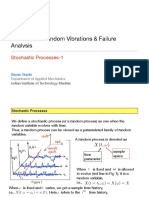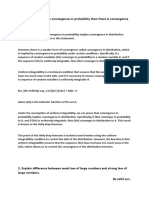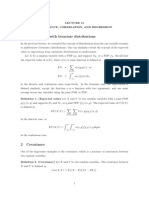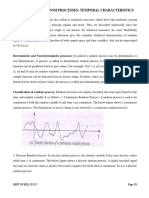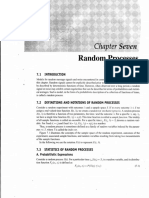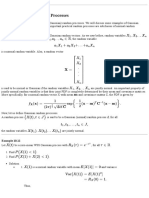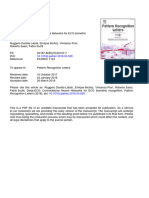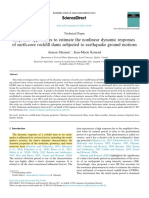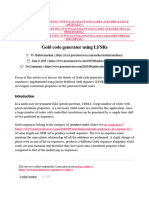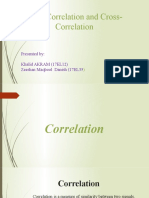11/24/2018 Multiple Random Processes
10.1.3 Multiple Random Processes
We often need to study more than one random process. For example, when investing in the stock market you consider several
different stocks and you are interested in how they are related. In particular, you might be interested in finding out whether two
stocks are positively or negatively correlated. A useful idea in these situations is to look at cross-correlation and cross-covariance
functions.
For two random processes {X(t), t ∈ J } and {Y (t), t ∈ J } :
− the cross-correlation function RXY (t1 , t2 ), is defined by
RXY (t1 , t2 ) = E [X(t1 )Y (t2 )], for t1 , t2 ∈ J ;
− the cross-covariance function CXY (t1 , t2 ), is defined by
CXY (t1 , t2 ) = Cov(X(t1 ), Y (t2 ))
= RXY (t1 , t2 ) − μX (t1 )μY (t2 ), for t1 , t2 ∈ J .
To get an idea about these concepts suppose that X(t) is the price of oil (per gallon) and Y (t) is the price of gasoline (per
gallon) at time t. Since gasoline is produced from oil, as oil prices increase, the gasoline prices tend to increase, too. Thus, we
conclude that X(t) and Y (t) should be positively correlated (at least for the same t, i.e., CXY (t, t) > 0).
Example 10.6
Let A, B, and C be independent normal N (1, 1) random variables. Let {X(t), t ∈ [0, ∞)} be defined as
X(t) = A + Bt, for all t ∈ [0, ∞).
Also, let {Y (t), t ∈ [0, ∞)} be defined as
Y (t) = A + C t, for all t ∈ [0, ∞).
Find RXY (t1 , t2 ) and CXY (t1 , t2 ), for t1 , t2 ∈ [0, ∞).
Solution
First, note that
μX (t) = E [X(t)]
= EA + EB ⋅ t
= 1 + t, for all t ∈ [0, ∞).
Similarly,
μY (t) = E [Y (t)]
= EA + EC ⋅ t
= 1 + t, for all t ∈ [0, ∞).
To find RXY (t1 , t2 ) for t1 , t2 ∈ [0, ∞), we write
RXY (t1 , t2 ) = E [X(t1 )Y (t2 )]
= E [(A + Bt1 )(A + C t2 )]
2
= E [A + AC t2 + BAt1 + BC t1 t2 ]
2
= E [A ] + E [AC ]t2 + E [BA]t1 + E [BC ]t1 t2
2
= E [A ] + E [A]E [C ]t2 + E [B]E [A]t1 + E [B]E [C ]t1 t2 , (by independence)
= 2 + t1 + t2 + t1 t2 .
https://www.probabilitycourse.com/chapter10/10_1_3_multiple_random_processes.php 1/2
�11/24/2018 Multiple Random Processes
To find CXY (t1 , t2 ) for t1 , t2 ∈ [0, ∞), we write
CXY (t1 , t2 ) = RXY (t1 , t2 ) − μX (t1 )μY (t2 )
= (2 + t1 + t2 + t1 t2 ) − (1 + t1 )(1 + t2 )
= 1.
Independent Random Processes:
We have seen independence for random variables. In particular, remember that random variables X1 , X2 ,...,Xn are
n
independent if, for all (x 1 , x 2 , . . . , x n ) ∈ R , we have
FX1 ,X2 ,...,Xn (x 1 , x 2 , . . . , x n ) = FX1 (x 1 )FX2 (x 2 ). . . FXn (x n ).
Now, note that a random process is a collection of random variables. Thus, we can define the concept of independence for
random processes, too. In particular, if for two random processes X(t) and Y (t), the random variables X(ti ) are independent
from the random variables Y (tj ), we say that the two random processes are independent. More precisely, we have the following
definition:
Two random processes {X(t), t ∈ J } and {Y (t), t ∈ J ′ } are said to be independent if, for all
t1 , t2 , … , tm ∈ J
and
′ ′ ′ ′
t , t , … , tn ∈ J ,
1 2
the set of random variables
X(t1 ), X(t2 ), ⋯ , X(tm )
are independent of the set of random variables
′ ′ ′
Y (t ), Y (t ), ⋯ , Y (tn ).
1 2
The above definition implies that for all real numbers x 1 , x 2 , ⋯ , x m and y1 , y2 , ⋯ , yn , we have
FX(t ′ ′
),X(t2 ),⋯,X(tm ),Y (t ),Y (t ),⋯,Y (t )
′ (x 1 , x 2 , ⋯ , x m , y1 , y2 , ⋯ , yn )
1 1 2 n
= FX(t ),X(t2 ),⋯,X(tm )
(x 1 , x 2 , ⋯ , x m ) ⋅ FY (t′ ′ ′
),Y (t ),⋯,Y (t )
(y1 , y2 , ⋯ , yn ).
1 1 2 n
The above equation might seem complicated; however, in many real-life applications we can often argue that two random
processes are independent by looking at the problem structure. For example, in engineering we can reasonably assume that the
thermal noise processes in two separate systems are independent. Note that if two random processes X(t) and Y (t) are
independent, then their covariance function, CXY (t1 , t2 ), for all t1 and t2 is given by
CXY (t1 , t2 ) = Cov(X(t1 ), Y (t2 ))
= 0 (since X(t1 ) and Y (t2 ) are independent).
← previous
next →
https://www.probabilitycourse.com/chapter10/10_1_3_multiple_random_processes.php 2/2








